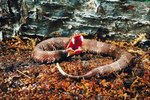
American crocodiles (Crocodylus acutus) are family Crocodylidae reptiles that come from the Americas, from the southernmost portion of Florida all the way down to Ecuador and Venezuela. They are some of the biggest crocodiles on the planet. When it comes to food, American crocodiles are opportunistic carnivores.
Basic Information
Size-wise, American crocodiles can get to a maximum of around 2,000 pounds, with lengths of a maximum of 15 feet. The females are a little smaller than the males. They share physical similarities with alligators, but have narrower physiques and lighter-colored bodies. The upper portions of their bodies are greenish-gray, while the lower portions are white or off-white. In terms of living environment, American crocodiles are found in many settings, including wetlands, sizable lakes, rivers, reservoirs, ponds and lagoons. They have life expectancies of approximately 45 years. Reproductive maturity usually occurs when they are between 8 and 10 years old. Female American crocodiles are rather meek parents, and it doesn't take much to scare them away from guarding their offspring.
Fully Mature American Crocodile Diet
Flesh is the food staple of American crocodiles. Some of the key dining preferences of adult individuals are turtles, frogs, fish, birds, snakes, little mammals and crabs. Once in a while, they feast on the decaying remnants of creatures that were killed beforehand by other predators. On the whole, American crocodiles aren't fussy and will go after anything that's mobile, as long as they can trap it. They also occasionally take in seedlings, although this could be unintentional. Attacks on people have occurred in the past, but are rare. In most cases, they attempt to escape the situations rather than aggressively confront humans.
Youngster Diet
Wee hatchling and juvenile crocodiles eat mostly tiny fish, tiny crustaceans, snails and bugs -- less substantial meals. Larger specimens -- including adults -- tend to go for larger prey animals, and smaller specimens for smaller mealtime targets. New hatchlings typically go after insects on terra firma.
Eating Style
The species' approach to going after prey is a secretive one. They stealthily lurk in the water without making even the slightest of motions. They only swoop in once their prey animals are close to them. American crocodiles handily retrieve them using their sturdy and strong jaws. Once they have their prey reliably in their clutches, they eat them whole. Since American crocodiles lead nocturnal lives, eating activities take place predominantly at night.
References
- USGS: American Crocodile
- IUCN Red List of Threatened Species: Crocodylus acutus
- University of Michigan Animal Diversity Web: Crocodylus acutus
- National Geographic: American Crocodile
- U.S. Fish & Wildlife Service: American Crocodile
- University of Florida IFAS Extension: American Crocodiles
- SeaWorld Animal Bytes: American Crocodile
- WAZA: American Crocodile
Photo Credits
-
Jupiterimages/Photos.com/Getty Images



